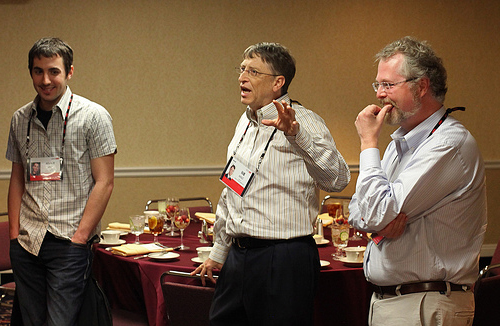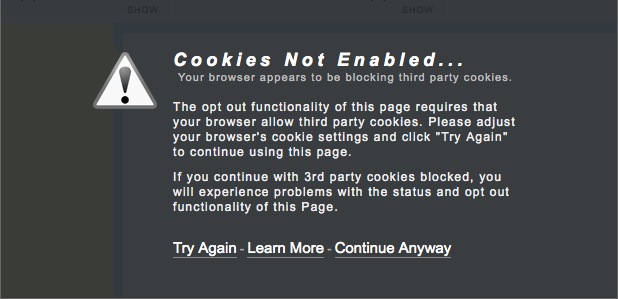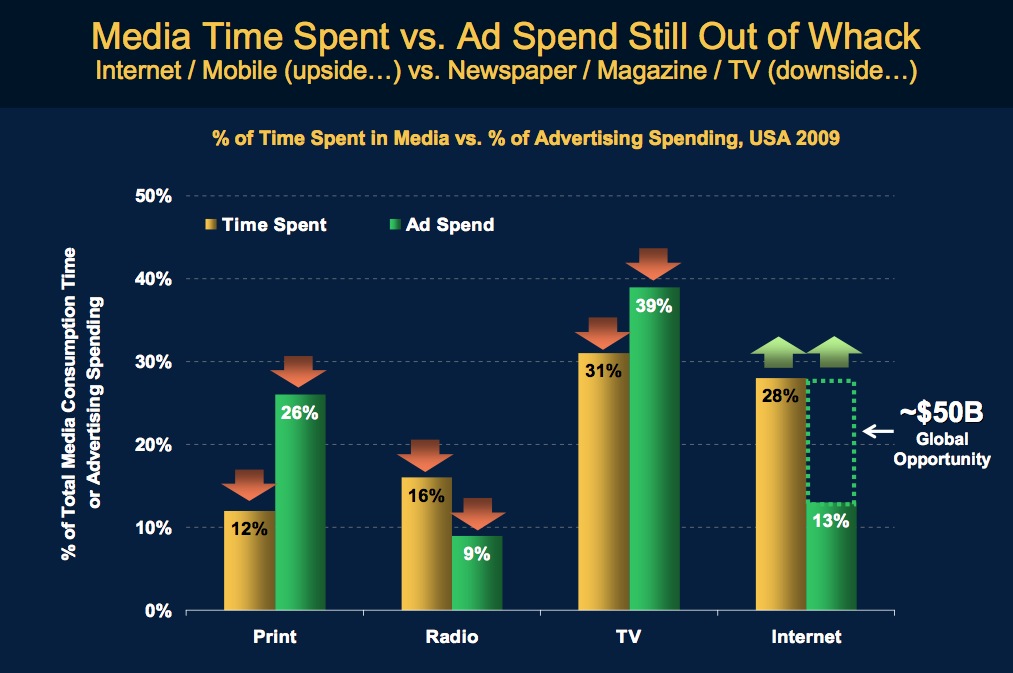9 Futurists Give 2020 Digital World Predictions to Mashable
July 11, 2012

9 Futurists give Mashable's Amy-Mae Elliott predictions for the digital future. Image courtesy of S58y. Used under Creative Commons license, http://creativecommons.org/licenses/by/2.0/deed.en.
We’re always interested in predictions for the future and were excited to be asked by Mashable’s Amy-Mae Elliott for one of our own in her article “9 Bold Predictions for the Digital World of 2020.” Dr. John Vanston chimed in on how voice quality by 2020 will be so excellent that “Younger generations will hear something that theretofore only older generations remember: the sound of a pin dropping.”
A couple of the futurists’ comments in the Mashable article refer to the massive amounts of information that is increasingly available to everyone. According to Dave Evans, Cisco Chief Futurist, “We are amassing unprecedented amounts of data – a zettabyte alone this year. This data is social and public (Facebook, Twitter, YouTube, blogs, etc.). Billions of devices (25-50 billion by 2020) will contribute exponentially to this avalanche of data … By 2015, Cisco Visual Networking Index predicts 1 million video minutes will traverse the Internet every second.”
According to Brian David Johnson, Futurist, Intel, “the size of the meaningful computational power keeps getting smaller and smaller. So, as we approach 2020 the size of the intelligent gets closer to zero in size, nearly invisible.”
Those that can use these massive amounts of information most imaginatively will have a very real advantage in the coming years. A good way to winnow through the information is finding minitrends in your areas of interest within the larger emerging trends. We talk extensively about this on this site and in our MINITRENDS book. Also stay tuned for our formal announcement of MINITRENDS 2012: A Conference on Translating Emerging Trends Into Business Opportunities scheduled October 17-18 at the Omni Downtown in Austin.
We are also intrigued by futurist Mike Walsh comments about virtual avatars: “By 2020 retail virtual avatars – on screens and in holographic projection – will start to become popular.” Perhaps, these virtual avatars will be waiting on us in the not too distant future!
We talk about Virtual Worlds being a minitrends opportunity in MINITRENDS. For the free excerpt from the book, see “Expanding Involvement in Virtual Worlds.”
Cheers,
Carrie
Business Model Trends – The Good, The Bad, and The Ugly
March 22, 2011

Kevin Rose of Digg, Bill Gates of Microsoft, and Nathan Myhrvold of Intellectual Ventures at the TED Conference (Photo courtesy of Steve Jurvetson).
Two days before an earthquake measuring 9.0 on the Richter scale struck Japan, resulting in a devastating tsunami and near meltdown at the Fukushima nuclear power plant, we wrote on this blog about “the growing interest in nuclear power” as an alternative to coal fired power plants.
Oops!
While nuclear power-generating facilities have been greatly improved since the Fukushima reactors were built — and the prospects for nuclear energy in the future are still bright — the timing is bad. The prospects for nuclear energy in the short term have dimmed as the costs associated with using that technology are being recalculated.
That wasn’t the only thing wrong with my blog post. A reader called my attention to the case against venture capitalist Nathan Myhrvold’s company, Intellectual Ventures. Myhrvold is the former chief technology officer of Microsoft whose new company invests in technology rather than investing in companies. Intellectual Ventures buys the rights to patents it likes, then markets those patents to other firms. Or does it?
According to Mike Masnick, the prolific and outspoken editor of TechDirt, Myhrvold’s venture is not based on marketing patents but on “shaking down” companies by suing anyone using its patents without permission. Masnick accuses Intellectual Ventures of disguising its true business model by using shell companies to file the lawsuits:
[Intellectual Ventures] had decided to protect its brand name by getting other companies or creating those companies itself, giving the patent to those other companies that no one had ever heard of, and having them sue.
Ouch!
While we did praise Myhrvold’s business plan on this blog, his method for picking technologies to invest in was our focus, not his manner of collecting on those investments. However, without beating up on ourselves too much, we should point out that another company with a strikingly similar business plan has been the recipient of tremendous admiration in the media these past few weeks.
I’m speaking of ARM, the technology company behind the low-heat computer chips used in Apple’s iPhone and iPad, along with many other smartphones and tablets. The company is not bashful about its creative structure:
ARM has an innovative business model. Instead of bearing the costs associated with manufacturing, we license our technology to a network of partners, mainly leading semiconductor manufacturers and OEMs. These partners utilise our designs to create smart, low energy chips suitable for modern electronic devices.
This structure — licensing technology rather than manufacturing it — has led to a gross margin for ARM of 94%. With revenue of $631 million in 2010, ARM had a profit of $593 million. You have to envy that ratio, no matter what business you’re in.
ARM’s business model is similar to Intellectual Venture’s stated mission, yet while Myhrvold is the recipient of scorn from TechDirt and others, ARM is getting nothing but love these days. Renown technology strategist, Michael J. Fern, gushes over ARM’s business model, saying it confers “three significant advantages over Intel.”
The Wall Street Journal joined the praise parade, with University of Chicago-trained economist and new “Heard on the Street” columnist, Rolfe Winkler, noting “ARM… doesn’t have to deal with manufacturing costs or the risks of holding inventory. It’s a deeply profitable business.”
The best take on ARM’s business model, from a Minitrends perspective, comes from the recent article by Om Malik at the influential blog, GigaOM. In a post critical of Twitter’s business model, the highly-respected tech journalist compares and contrasts the business models of half-a-dozen tech companies, including Xerox, Apple, Google, and ARM. Relying heavily on the work of business guru Alex Osterwalder, Malik concludes that “the business model innovation is what turns great products into fearsome companies.”
Sometimes, the most beautiful business models can turn ugly down the road. I was teaching a workshop once when a perplexed attendee kept interrupting with questions. “How do you generate sales,” he asked. “I don’t have sales,” I answered, “I only have expenses. All I have to do is cover my expenses.”
I was describing the workings of a technology startup that made videos of businesses without charging those businesses. Costs were recouped by finding sponsors to cover the expenses. The fellow in the back of the room couldn’t understand the business model and, as it turns out, neither could investors or sponsors. An early online video play, the company died in 2008 for lack of revenue.
The clever idea of yesterday can seem brilliant or stupid a few years — or even a few days — later. That’s why, for your own Minitrends Adventure, we recommend spending as much time thinking about the business model as you do about the services or goods being sold.
STEVE O’KEEFE
News Editor, Minitrends Blog
Source: “Nathan Myhrvold on Uncovering and Investing in Technology Trends,” Mintrends Blog, March 9, 2011
Source: “Nathan Myhrvold’s Intellectual Ventures Using Over 1,000 Shell Companies To Hide Patent Shakedown,” TechDirt, Feb. 17, 2010
Source: “ARM Disrupting Intel with its Business Model?,” FernStrategy, March 10, 2011
Source: “Getting an ARM Up on Intel,” The Wall Street Journal, March 17, 2011
Source: “What Is Twitter’s Problem? No, It’s Not the Product,” GigaOM, March 8, 2011
Photo courtesy of Steve Jurvetson, used under its Creative Commons license.
IDC Sees Perfect Storm in Portable Computing
December 8, 2010

On December 2, International Data Corporation (IDC), the giant IT research firm out of Framingham, Massachusetts, released its annual predictions for IT in the coming year. The firm is forecasting a perfect storm for IT: a combination of cloud computing, mobile computing, and social networking that threatens to consign desktop PCs to the storage closet.
The author of the survey is IDC’s chief analyst, Frank Gens, who leads IDC’s 1,000 analysts in 110 countries in tracking IT trends. Summarizing this year’s report, Gens sees a nearly complete transformation in the dominant computing platform:
What really distinguishes the year ahead is that these disruptive technologies are finally being integrated with each other — cloud with mobile, mobile with social networking, social networking with ‘big data’ and real-time analytics. As a result, these once-emerging technologies can no longer be invested in, or managed, as sandbox efforts around the edges of the market. Instead, they are rapidly becoming the market itself and must be addressed accordingly.
As the IDC report ripples through the Internet, different players are examining what it means for the future of computing. At ComputerWorld, Sharon Gaudin comments on the surge in social networking, suggesting that business startups will stop building expensive and complicated websites and opt for free Facebook pages instead.
Anuradha Shukla at TechWorld is enthusiastic about IDC’s upbeat predictions for IT expenditures. The report forecasts a 5.7% increase in outlays over 2010, to $1.6 trillion worldwide. IDC sees half of that spending coming from emerging market countries shrugging off the recession.
At PC World, Patrick Thibodeau focuses on IDC’s prediction that shipments of apps-enabled mobile devices — smartphones and tablets — will surpass shipments of PCs in the next 18 months. Thibodeau points out, however, that shipments of PCs are not declining; rather, they are growing, but not nearly as quickly as mobile devices.
Another prediction that is sure to catch the eye of venture capital firms: Gens says that nearly a third of the major players in social networking will be bought up in the coming year by the likes of Oracle, Microsoft, HP, and IBM, who need to get in the game.
While many others futurists we have covered on the Minitrends blog have made similar predictions about the growth in cloud computing, mobile computing, and social networking, none of them have joined them together with such a powerful vision of a whole new way of working that Frank Gens brings to IDC’s report.
What do you think is coming in 2011? Do you think it will be just more of the same, or the beginning of a totally new platform, as the IDC report speculates? We welcome your comments.
STEVE O’KEEFE
News Editor, Minitrends Blog
Source: “IDC Predicts Cloud Services, Mobile Computing, and Social Networking to Mature and Coalesce in 2011, Creating a New Mainstream for the IT Industry,” IDC Press Release, 12/02/10
Source: “Business will get more social in 2011, IDC says,” ComputerWorld, 12/06/10
Source: “Cloud services, mobile computing and social networking to mature in IT industry,” TechWorld, 12/07/10
Source: “In historic shift, smartphones, tablets to overtake PCs,” PC World, 12/07/10
Photo by davedehetre (David DeHetre), used under its Creative Commons license.
FTC Advocates Do-Not-Track; Advertisers Upset
December 3, 2010

Screen capture from the Interactive Advertising Bureau's "AboutAds.info" opt-out page. To install the IAB's opt-out software, users must expose their browser to significant privacy risks by enabling cookies.
On December 1, the U.S. Federal Trade Commission presented a preliminary report (PDF) outlining a “framework for privacy” that endorses a “Do-Not-Track” option for Web browsers similar to the agency’s popular “Do-Not-Call” service for telephones.
Unlike the Do-Not-Call program, which creates one central place where individuals can easily add their phone numbers to the list, with reprisals for companies that violate their preferences, the Do-Not-Track mechanism (“DNT”) will be built into the Web-browsing software and other applications used to access the Internet from computers, tablets, and smartphones. Each piece of software or app would have to include a DNT feature. Currently, there are no proposed guidelines for consistently implementing that feature, nor any real authority to enforce it.
Forbes‘ new privacy blogger, Kashmir Hill, says, “At the end of the day, this report isn’t going to change anything.” Kevin Fogarty, the highly opinionated blogger for ITworld‘s “CoreIT” blog, is blunt in his assessment, calling the FTC report:
[…] a set of recommendations with roughly the same clarity, credibility and impact of a strongly worded letter from the U.N. to this year’s evil dictator asking him to please not kill and eat so many villagers.
At The Huffington Post, consumer rights activist Jamie Court threatens a privacy initiative in California: “If Congress doesn’t act, we will go to the ballot.”
While Internet giants, including Google and Microsoft, have learned to tame their public pronouncements and pay lip service to the FTC’s recommendations, they let the trade groups they fund do the barking for them. Mike Zaneis, senior vice president and general counsel of the Interactive Advertising Bureau (IAB), is quoted by The New York Times media reporters Edward Wyatt and Tanzina Vega as saying that the DNT mechanism will cause “significant economic harm” if it has “a high participation rate similar to that of do not call.”
The IAB is recommending voluntary measures where sites place prominent “opt-out” buttons that disable tracking, rather than a central registry or browser build-ins. The organization touts its AboutAds.info site, where you can opt out of being tracked by a very small group of sites that participate.
John and Carrie Vanston devote a major section of their new book, MINITRENDS, to business opportunities arising from increasing interest in privacy. They predict that the U.S. will strengthen its privacy laws, opening up profitable new business lines for entrepreneurs:
The federal government of the United States has adopted only limited formal legislation to protect privacy compared to Canada and most European countries.
Among the businesses that will profit from strengthening privacy laws are software developers, training firms, and the new field of online reputation management companies.
Certainly, someone needs to come up with a solution better than the IAB’s “opt-out” site. When this reporter visited the site to test the opt-out features, I was advised I would have to enable cookies in order to install the software (see screen capture, above). While enabling cookies would protect me from being tracked by few dozen sites participating in the IAB’s program, it would open me to tracking by the millions of sites that not only don’t participate, but sometimes use methods that are much more intrusive than those of IAB’s supporters — methods which remain, unfortunately, virtually unregulated.
STEVE O’KEEFE
News Editor, Minitrends Blog
Source: “Protecting Consumer Privacy in an Era of Rapid Change” (PDF), Federal Trade Commission, 12/10
Source: “Brief Takeaways — and a Pretty Diagram — from the FTC’s Online Privacy Recommendations,” Forbes, 12/01/10
Source: “FTC becomes aware there is an Internet,” ITworld CoreIT Blog, 11/17/10
Source: “Will We Get a ‘Do Not Track Me’ List for Our Personal Information Online?” The Huffington Post, 12/01/10
Source: “F.T.C. Backs Plan to Honor Privacy of Online Users,” The New York Times, 12/01/10
Source: MINITRENDS How Innovators & Entrepreneurs Discover & Profit From Business & Technology Trends, p. 97.
Image from AboutAds.info, the Interactive Advertising Bureau’s “opt-out” site, screen capture recorded 12/02/10. Used under Fair Use: Commentary.
Google’s Schmidt: “Bump to Buy” Coming Soon to Mobile Phones
November 18, 2010

Google CEO Eric Schmidt holding a new "device" that includes a "bump to buy" NFC chip at the Web 2.0 Summit.
Google CEO Eric Schmidt is keen on mobile phones. He says that people don’t realize how powerful these devices are, and claims they are “more powerful” than desktop computers.
Schmidt made these remarks on November 15 at O’Reilly’s Web 2.0 Summit in San Francisco, where he was grilled for almost an hour by Tim O’Reilly and John Battelle. Both O’Reilly and Battelle come from the world of publishing. O’Reilly is founder and CEO of O’Reilly Media, a well-known publisher of computer books and conference organizer. Battelle was a co-founder of Wired magazine and currently runs Federated Media, an online advertising firm. A video of their conversation with Eric Schmidt is available through the Web 2.0 Summit website.
Early in the interview, Schmidt pulls out a prototype “device” which looks very much like a mobile phone. He explains how this new device, which will appear on the market in the coming weeks, will use a “near field communication” (NFC) chip that you can wave or bump against something to get information about a product, person, or place.
With current 3G smartphones, you can take pictures with your phone and use those pictures to search the Web for information about a product or place. On another blog I write for, the SixEstate blog, online journalism expert Rachelle Matherne describes how smartphones can snap pictures of quick response barcodes (“QR codes”) and get additional information about an advertiser’s products.
The hang-up is that using QR codes requires adding an app to your phone, then taking a picture of the barcode with your phone’s camera. Near field communication eliminates all that fuss. You just bump the item with your phone and instantly retrieve all kinds of information. You can bump a book and discover other books by the same author, or deals offered by multiple vendors on the same product.
The bump gets even better when you attach it to a digital wallet. The new smartphones will enable consumers to “bump to buy,” according to O’Reilly. In his coverage of the Web 2.0 Summit, InformationWeek editorial director, Fritz Nelson, says that “bump to buy” will take time to spread:
This requires an ecosystem of merchants, payment providers and payment processors, and while this ecosystem is starting to form, it’s still evolving. Schmidt later told a gathering of reporters that broader acceptance is probably a year away.
Schmidt, who usually wears a severe demeanor, was positively giddy about the potential of the next generation of mobile phones. He says they are more personal, more secure, and more powerful than desktop computers, and that “mobile first” is his mantra, meaning that the phone will be the focus of Google’s strategy in the coming years.
How important are Schmidt’s remarks to driving the industry? Of the 25 videos posted from the Web 2.0 Summit as of this writing, Schmidt’s interview has been viewed over 120,000 times. Compare that to Zynga’s Mark Pincus — and most of the other well-known speakers — whose videos have been watched only a few hundred times, and you can see that Google is still the engine of innovation driving the new economy.
STEVE O’KEEFE
News Editor, Minitrends Blog
Source: “Web 2.0 Summit 2010: A Conversation with Eric Schmidt,” OReillyMedia, 11/15/10
Source: “Google CEO Schmidt Says NFC To Extend Android Acceptance,” InformationWeek, 11/15/10
Source: “QR Codes and the New Journalism,” SixEstate Blog, 11/09/10
Photo: Screen capture from “A Conversation with Eric Schmidt,” courtesy OreillyMedia.
Meeker’s Top Internet Trends: Online Advertising Undervalued
November 17, 2010

Mary Meeker runs the global technology research team as a managing director of investment giant, Morgan Stanley. When Meeker talks, the market listens, and she was saying plenty at the recent Web 2.0 summit in San Francisco.
On Tuesday, November 16, Meeker shared her picks for the top Internet trends, backed up with some of the most cleverly crafted stats I’ve ever seen. Among the revelations: Print publications occupy only 12% of the amount of time consumers spend with media, yet account for 26% of advertising spending. This does not bode well for the future of advertiser-supported print media.
On the other hand, Meeker’s stats show that the Internet takes up 28% of people’s time for media, yet draws only 13% of advertisers’ budgets. She says there’s $50 billion too little being spent in online advertising.
Mashable’s Ben Parr summarized Meeker’s misallocation thusly: Facebook is “the most under-monitized asset in online advertising.” According to Meeker’s stats, social networking is earning a mere 55 cents per thousand impressions (CPM) from advertisers. Compare this to CPM’s of about $2.70 for the majority of websites that accept display advertising. Also grossly undervalued, according to Meeker, are display ads embedded in email, which earn only 89 cents CPM.
Parr was modest enough not to mention that Mashable ranked as one of the Top 10 brands on Twitter, coming in at position number 10 — right behind the National Basketball Association (NBA) and just ahead of Martha Stewart.
Another slide in Meeker’s presentation compared the number of people who “like” brands on Facebook with the number of viewers for popular television programs — and the CPMs associated with those TV shows. Zynga’s Texas Hold’em Poker leads the likes on Facebook with 27.2 million, which is roughly equivalent to the number of American Idol viewers. Whereas display ads on Facebook cost a mere $0.55 per thousand impressions, American Idol charges $30. We profiled Zynga founder Mark Pincus here on the Minitrends blog last month, where he talked about the importance of good eating habits.
Some of the other trends mentioned in the book, MINITRENDS, which also caught Mary Meeker’s eye, include the growth of virtual worlds. Meeker favorably compared the Japanese social networking site, Tencent (637 million active users), with Facebook (620 million annual visitors). The difference? Tencent is a virtual world using avatars. The shocking stat that caught my attention: over $1.4 billion in virtual goods have been sold on Tencent! Those are real yen shelled out for virtual merchandise such as outfits for avatars.
Another shocking stat: Seven of the top 15 Internet companies by market capitalization in 2004 are not in the top 15 today. Punishment is swift for those who do not stay on the edge of innovation. Case in point: Nokia and RIM held 70% of the smartphone market as recently as 2008. Today, that market share has dropped to 52% while Google (Android) and Apple (iPhone) have gone from nothing to gobbling up 42% of the market.
Despite a Morgan Stanley copyright notice, Mary Meeker’s slideshow seems to be everywhere online. You can find it at Mashable and TechCrunch, along with some very cursory commentary.
STEVE O’KEEFE
News Editor, Minitrends Blog
Source: “The Unprecedented Rise of Apple iOS and Other Internet Trends,” Mashable, 11/16/10
Source: “Mary Meeker On Ten Questions Internet Execs Should Ask And Answer,” TechCrunch, 11/16/10
Image from Morgan Stanley, used under Fair Use: Commentary.
Nonprofits Take Social Networking to New Heights
November 12, 2010
 Social networking is a megatrend that has been gaining momentum since bulletin boards first made it possible for people to schmooze online in the 1980s. Out of this megatrend have come numerous Minitrends that investors have profitably mined over the past five years, including social bookmarking, tagging, and location-based networks such as Foursquare.
Social networking is a megatrend that has been gaining momentum since bulletin boards first made it possible for people to schmooze online in the 1980s. Out of this megatrend have come numerous Minitrends that investors have profitably mined over the past five years, including social bookmarking, tagging, and location-based networks such as Foursquare.
Steve Monfort, a writer for NASDAQ.com, recently reported on the growing trend of small businesses hiring more people to handle social media:
A recent American Express survey shows that 40 percent of small businesses are using social networking to promote their offerings, up from 10 percent a year ago.
While small businesses are just warming-up to social networking, nonprofit organizations were among the earliest to embrace the trend. By now, everyone has heard about “text-to-give,” which was used by the American Red Cross to collect $30 million from cellphone users for earthquake relief in Haiti last year. According to nonprofit tech guru Tonia Zampieri, sales and marketing manager for LoyaltyClicks, a division of Smart Online, text-to-give is so 2009.
Smart Online recently conducted a survey into technology trends for nonprofit organizations. The results were reported on NTEN, the Nonprofit Technology Network, just a few days ago. They indicate that over 90% of nonprofits actively use social networking (compared with only 40% of small businesses, according to American Express). The breakdown: 91% use Facebook, 63% use Twitter, 45% use YouTube, and 35% use LinkedIn.
You would think that level of penetration would be cheered by the nonprofit experts at LoyaltyClicks. But Zampieri has found a weakness in charity tech: mobile myopia. She writes:
[O]nly 16% of the surveyed nonprofits plan on having mobile websites in 2011, while 19% plan on having smartphone applications.
Zampieri cites a Nielson study that almost one-quarter of the time people are online is spent using social networks — and that half of that social networking is done with mobile devices. Then she provides “compelling reasons why a mobile website or a mobile application might work better for your organization” than, for example, old-fashioned text-to-give:
- donations aren’t limited to $5 or $10
- donations are received immediately
- you capture and control crucial data about your donors
- any size charity can use this technology, not just giants
- it’s a permanent tool, not just a one-shot appeal
For inspiring examples about the way nonprofit organizations are innovating with social networking, we recommend a recent Mashable story on “5 Must-Follow Non-Profits Making a Difference With Social Media.” The article is a run-up to the annual Mashable Awards which will be held January 6, 2011, at the Consumer Electronics Show (CES) in Las Vegas.
I was particularly impressed by the way the Brooklyn Museum has made use of a wide variety of social networking Minitrends to engage visitors and benefactors both online and in person. The museum has a dedicated mobile site (LoyaltyClicks would approve) that allows browsers to tag the museum’s 94,000 piece collection, making it easier for visitors to locate must-see art based on other patrons’ comments. They also use Foursquare to provide restaurant suggestions and other ideas to fill out a trip to the museum.
If you have any other examples of nonprofits who are making innovative uses of social networking applications, we’d like to hear about them. And so would Mashable! The Mashable Awards are open for nomination until November 29.
STEVE O’KEEFE
News Editor, Minitrends Blog
Source: “Job growth anticipated in cloud computing, apps, social media,” NASDAQ.com News, 10/15/10
Source: “Technology Trends for Nonprofits in 2011,” NTEN, the Nonprofit Technology Network, 11/08/10
Source: “5 Must-Follow Non-Profits Making a Difference With Social Media,” Mashable, 11/06/10
Image courtesy of Lisa Brewster, used under its Creative Commons license.


